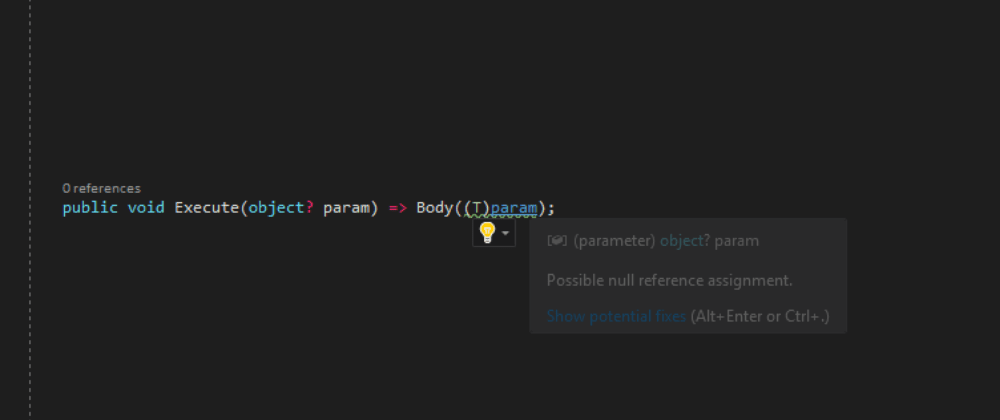There are already some posts about C# 8's nullable reference types. Adopting this new feature has been great fun! And almost all existing code can be adapted to use this feature to improve it's safety.
Almost all code...
Initializers
Using initializers is somewhat common. In this example it's used to avoid duplicate code in multiple constructors, but there are other use cases:
- To split complex initialization code into nicely maintainable smaller methods
- To avoid throwing exceptions from a constructor
- To have
asyncinitialization logic
Consider this class:
class ClassWithInit
{
public object SomeProperty { get; set; }
public ClassWithInit() { // ⚠ Warning: Non-nullable property 'SomeProperty' is uninitialized.
Init();
}
public ClassWithInit(string someArg) {
Init();
}
// This class has multiple constructors,
// initialization logic is reused by placing it in an 'Init' method.
private void Init() {
SomeProperty = ...;
}
}
Even though you call Init from the constructor and are therefore certain the property will be initialized the compiler doesn't realize this. To get rid of the warning you can trick the compiler:
public object SomeProperty { get; set; } = null!;
This looks a bit odd and if you ever rewrite the Init method and forget to initialize the property you won't be warned!
Events
A minor gripe I have is having to mark all my events as nullable:
event PropertyChangedEventHandler? PropertyChanged;
Event handlers are of course objects, but because of the +=, -= syntax we hardly think of them as such and, for me at least, raising events with ?.Invoke(...) is basically second nature.
Marking eventhandlers as nullable is a logical consequence of the new syntax and we'll just have to get use to it. But it can be a bit of a shock when you set nullable to enabled on an existing project and are confronted with hundreds of warnings on completely harmless code.
Generics
While the new ? syntax looks similar to existing System.Nullable<T> syntax for structs, it is completely different in practice. You mainly notice this when working with generic classes, especially when you don't specify a where T : class/struct constraint.
Take for example this RelayCommand<T> class (DelegateCommand in Prism), a common construction in WPF projects:
public class RelayCommand<T> : ICommand
{
public Action<T> Body { get; }
public void Execute(object? param)
=> Body((T)param); // ⚠ Warning: Possible null reference assignment
public RelayCommand(Action<T> body)
{
Body = body;
}
// 'CanExecute' functionality omitted for brevity
}
The parameter T could be anything: struct or class, this makes this class more generally useful. Moreover the parameter param of the Execute method should be marked nullable as it is probably called from a XAML binding to CommandParameter and who knows if that'll be null. (Even a RelayCommand<int> could be called with null as the parameter since Execute(...) simply takes an object as parameter)
In a perfect world we'd write:
public Action<T?> Body { get; } // Error
That would fix the warning now produced by the Execute method and it would helpfully inform users of this class that they must provide a delegate capable of handling null values to the constructor. Alas, this is not possible, changing the property type to Action<T?> results in an error:
CS8627: A nullable type parameter must be known to be a value type or non-nullable reference type. Consider adding a 'class', 'struct' or type constraint.
But keeping the code as it is could lead to dangerous situations. Consider:
// Dangerous code, but no warning:
new RelayCommand<string>(s => Console.Write(s.Length));
// Safe code:
new RelayCommand<string?>(s => Console.Write(s != null ? s.Length : -1));
Because string 's' could be null the first piece of code mights still lead to the dreaded NullReferenceException. The proper code specifies the type as string? but there is no warning to remind you to do so.
The solution, sadly 😢, is to create two versions of this class, one for reference types, and one for structs.
If we add the constraint where T : class to our RelayCommand<T> class we can now use type Action<T?> as 'Body'. After this change passing a method to the constructor that forgets to check for null will result in a warning: Huzzah, we've done it 🎉. This results in safer code, exactly what this new feature is for. Shame it means having write two versions of a class which before this feature was perfectly happy handling both structs and classes.
Or is there another way?
Attributes
In some cases the issues with generics which accept both structs and classes can be mitigated using C# 8's new attributes:
// Event args for an event which is raised when some property of type 'T' is changed,
// works for both structs and classes thanks to attributes
public class ItemChangedEventArgs<T> : EventArgs
{
[MaybeNull]
public T OldValue { get; }
[MaybeNull]
public T NewValue { get; }
public ItemChangedEventArgs([AllowNull]T oldValue, [AllowNull]T newValue)
{
OldValue = oldValue;
NewValue = newValue;
}
}
This class behaves exactly as you'd hope it would, for example:
-
new ItemChangedEventArgs<string>(null, "")doesn't produce a warning even though null is passed andTis not markedT?. -
((ItemChangedEventArgs<object>)var1).NewValue.ToString()produces a warning because object is a reference type and 'NewValue' could be null. -
((ItemChangedEventArgs<int>)var2).NewValue.ToString()doesn't produce a warning because the compiler realises anintis never going to be null.
There is also the notnull constraint which mitigates some other generic-related issues, but this post is getting too long...
Conclusion
Generally C# 8's nullable reference types is a neat feature which is sure to improve code quality and reduce bugs. And even if there are still minor exception where you do have to worry about null, we can be grateful nothing is undefined at least 😉.
Share your thoughts! Have you run into any problems related to this new feature? Or do you have some brilliant way to handle the issues I've laid out? Be sure to leave a comment.







Latest comments (5)
How do you enable nullable for the entire project? I’ve seen multiple ways.
It seems the preferred way in the release version is to add:
To your
.csprojfile.Okay, because I have also seen;
During the previews of C# 8.0 that was the way to do it. In the release version however
<Nullable>is preferred. For example, the official docs use it.Thanks. That doc is 9 months old (before v3.0) I’ll give it a try.